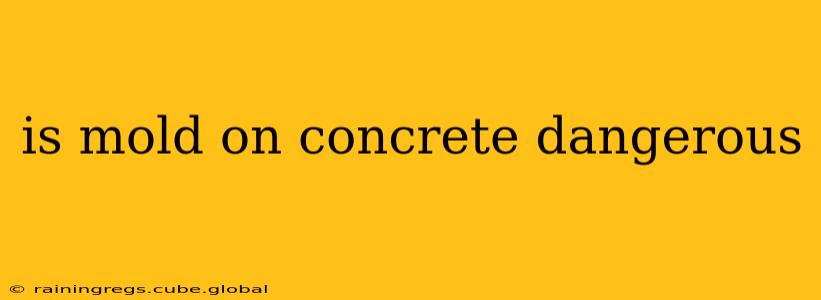Mold growth on concrete, while unsightly, can pose significant health risks if left unaddressed. The danger isn't solely from the mold itself, but also from the potential for structural damage and the release of harmful spores into the air. This comprehensive guide will explore the dangers of mold on concrete, how to identify it, and what steps to take for remediation.
What are the health risks of mold on concrete?
Mold spores, microscopic particles released by mold colonies, are the primary concern. Inhaling these spores can trigger various allergic reactions and respiratory problems, ranging from mild irritation to severe conditions. These health risks are exacerbated by the porous nature of concrete, which can harbor mold deep within its structure, making complete eradication challenging. People with pre-existing respiratory conditions like asthma or compromised immune systems are particularly vulnerable. Symptoms can include coughing, sneezing, watery eyes, skin rashes, headaches, and in severe cases, difficulty breathing.
What types of mold are commonly found on concrete?
Several mold species thrive in damp concrete environments. Common culprits include Cladosporium, Aspergillus, Penicillium, and Stachybotrys chartarum (often called "black mold"). While all mold types can cause problems, Stachybotrys chartarum is particularly concerning due to its association with mycotoxins, potent toxins that can cause more severe health issues. However, it's crucial to understand that not all black mold is Stachybotrys. Proper identification requires laboratory analysis.
How can I identify mold on concrete?
Mold on concrete can manifest in various colors, from black, green, gray, and white to other hues. It often appears as fuzzy patches or discoloration on the surface. However, the presence of mold isn't always visually obvious. It can grow beneath the surface, making detection more challenging. A musty odor is often a strong indicator of hidden mold growth. If you suspect mold, it's always best to err on the side of caution and investigate further.
Is mold on concrete structurally damaging?
Yes, mold growth can weaken concrete structures over time. As mold colonies expand, they can release acids that erode the concrete, causing deterioration and compromising the structural integrity of the affected area. This is especially true in areas with consistently high moisture levels. The damage can range from minor surface degradation to significant cracking and weakening, depending on the extent and duration of the mold infestation.
How can I prevent mold growth on concrete?
Prevention is key to mitigating the risks associated with mold on concrete. Maintaining proper ventilation, controlling moisture levels, and promptly addressing any leaks or water damage are essential steps. Regularly inspecting concrete surfaces for signs of mold and promptly addressing any issues will help to prevent extensive damage and associated health risks. Using moisture barriers and sealants can also provide an added layer of protection.
How should I clean mold from concrete?
Cleaning mold from concrete requires caution. Never attempt to clean mold without appropriate protective gear, including a respirator, gloves, and eye protection. For small, localized areas, a solution of bleach and water (following manufacturer's instructions carefully) can be effective. However, for extensive mold growth or if you're unsure how to handle it safely, it's best to consult with a professional mold remediation specialist. Improper cleaning techniques can disperse mold spores, exacerbating the problem.
What are the costs associated with mold remediation on concrete?
The cost of mold remediation on concrete varies significantly depending on the extent of the infestation, the size of the affected area, and the specific remediation methods required. Smaller, localized areas might be relatively inexpensive to clean, while extensive infestations could necessitate costly professional intervention involving demolition, removal, and replacement of affected materials. Getting multiple quotes from reputable contractors is always recommended.
This information is for general knowledge and does not constitute professional advice. For specific concerns about mold growth in your home or building, consult a qualified mold remediation specialist. They can assess the situation, recommend appropriate remediation strategies, and ensure your safety and the structural integrity of your property.
